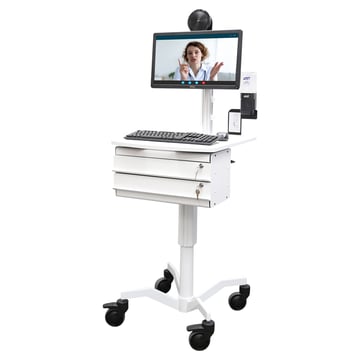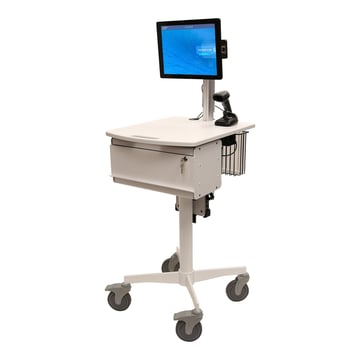By First Products on Oct 28, 2021 9:59:00 AM
All too often, residing in rural areas means limited access quality healthcare services.
Physician shortages, hospital closures, a lack of local specialty services and transitional care are just a few of the factors that have profoundly impacted these underserved – underinsured -- communities.
Meeting these challenges will require a multi-faceted strategy focused on improving availability, accessibility, and affordability, including th adoption of telemedicine and other telehealth program that enable patients in rural communities to connect with distant providers and services.
Rural Healthcare Services: The Scope of the Problem

According to the U.S. Department of Health and Human Services, nearly 25% of all Americans live in rural communities. Yet only about 10% of the nation’s physicians practice in those areas.
Rural hospitals have also been closing at an alarming pace, with at least 136 facilities shutting their doors since 2010, while a lack of staff and financial support have forced many remaining facilities to shift their emphasis to outpatient care. And because the efficient delivery of services is more difficult in areas with low population density, far too many rural patients are being denied the benefits of basic preventive care, including cancer screenings, vaccinations, prenatal care, well child visits, and more.
Not surprisingly, this limited access has contributed to less favorable outcomes for rural compared to their urban counterparts:
- Rural counties have had the highest rates of premature death for many years, lagging far behind other counties.
- While urban counties continue to show improvement, overall rates of premature death are worsening in rural counties.
- Nearly one in five rural counties has experienced worsening premature death rates over the past decade.
Telehealth and Telemedicine Can Improve Medical Services for Rural Patients
Telehealth is a broad term that refers to the electronic and telecommunications technologies used to provide healthcare services at-a-distance. Telemedicine is one facet of telehealth that describes the practice of medicine using videoconference technology for virtual exams and consults.
The ongoing COVID-19 pandemic has given telemedicine new prominence, as both patients and providers seek ways to limit in-person interaction and prevent transmission of the potentially deadly virus. Telemedicine technology is also being used to eliminate many of the challenges rural patients face when attempting to access healthcare service, especially the transportation-related issues that prevent many from seeking mental health and other specialty care.
Beyond telemedicine, other forms of telehealth can go a long way to improving healthcare access in rural areas.
- Chronic Care Management Interventions: Rural doctors can leverage telehealth technology to provide patients with access to integrated care during their primary care visits.
- Provider-to-Provider Connections: Telehealth platforms facilitate E-consults and other virtual interactions that allow rural providers and distant specialists to share knowledge and manage patient care.
- Timey Emergency Care: When minutes and even seconds matter, telehealth technology can connect on-scene responders in rural areas with distant emergency care providers and trauma centers for real-time evaluations and consults.
- In-Home Monitoring: Telehealth remote monitoring programs can help patients with chronic disease management and behavioral health conditions in their homes.
- In-Patient Monitoring: Telemonitoring platforms that utilize two-way audio-visual communications allow rural healthcare facilities to provide 24/7 in-room observation for at-risk patients. This is especially beneficial when staff shortages or financial constraints prevent the utilization of in-person bedsitters.
- Improved Access for Long-Term Care Residents: Telemedicine and other telehealth platforms can improve access to specialists and services for elderly residents when assisted living facilities and nursing homes are located in rural areas.
- Online Mental Health Services: Rural residents can utilize their internet connection to access mental health providers and services affiliated with urban medical centers.
- Access to Interpreter Services: Telehealth technology allows Interpreter services to be transmitted on-demand through audio and/or visual technology when a patient speaks limited or no English.
- School-Based Telehealth Services: Rural schools can utilize telehealth platforms to connect students with mental health services and counseling. School-based use of the same technology can also increase access to many pediatric healthcare services.
- Electronic Medical Records: Telehealth technology allows rural providers to quickly and easily transmit patient electronic medical records for consults with distant specialists.
- mHealth: mHealth is a general term for the use of mobile phones and other wireless technology in medical care. While the most common application of mHealth is the use of mobile devices to educate consumers about preventive healthcare services, these platforms can also be used disease surveillance, treatment support, epidemic outbreak tracking and chronic disease management.
First Products is Committed Improving Healthcare Services in Rural Areas

First Healthcare Products is committed to helping providers improve healthcare services in rural areas.
From telemedicine carts and tablet roll stands to WOW carts and EMR/EHR charting technology, we offer a range of perfect-fit solutions designed to ensure the success of your telehealth program.
We've been assisting healthcare professionals and medical providers in rural communities for over 50 years. If First Healthcare doesn’t already have your perfect-fit telemedicine or telehealth solution available, we'll customize one for you.
To Learn More and to Arrange for Your Complimentary Demo, Contact First Products Today at 800.854.8304.
_11wX8.5h-FINAL.png?width=721&name=FP-Logo-Horizontal-(COLOR)_11wX8.5h-FINAL.png)



comments